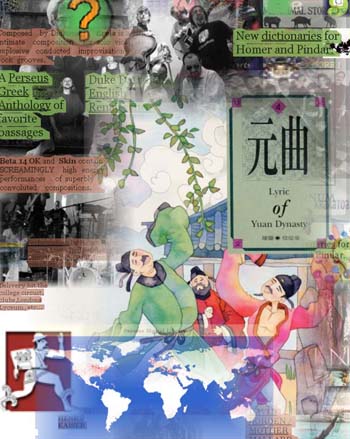about > idea

combinFormation is a creativity support tool that integrates processes of searching, browsing, collecting, mixing, organizing, and thinking about information. We believe the primary purpose of digital information is to support your creative idea generation. Images and text engage complementary cognitive subsystems. Each collection of information resources is represented as a connected whole. This promotes information discovery, the emergence of new ideas in the context of information. Temporal visual composition generates a continuously evolving informationscape. Agents work together with you to:
Generative agents help you. This is what is meant by mixed-initiative In order to help you, the agents need to understand what you are interested in. We provide tools for expressing interest, and for designing the space.
generative agent
The generative agent doesn't wait for you to click through links. It composes the space procedurally, based on its model of your interests. It includes a web crawler, that will run through links automatically. The agent will carve the web pages it finds up into sets of information samples. It will periodically place a sample into the visual space for you. When the space gets filled, it will also remove elements. You can turn the agent on and off, and control its speed, using the tape recorder controls.
information samples
The information samples (or clippings) may be images and small chunks of text. Information samples that come from the net include references back to their original web pages. They also may include hyperlinks to other pages. The composition space enables you to navigate from an element to its container, and any hyperlink(s). In this way it works as a graphical collection of bookmarks.
recombinant information
What we think is really cool is how when elements are next to each other, new meanings are suggested through combination. This is like how genes are exchanged through DNA. We call this effect of generating new meanings through remix juxtaposition recombinant information.
element rollover
You can also see each element distinctly by placing your mouse over it. At the same time, descriptive information will be displayed. This is called metadata. You can also edit the metadata.
what-it's-for
You can express yourself with the program to create composition spaces on a topic. These are visual collections of information samples. The spaces may help you get a fresh perspective on materials with which your already familiar. You can also share these composition spaces with others by publishing them on the web. The composition space will act as a special active web page. The people who browse your compositions spaces will be able to modify them with the same tools you have. They can navigate back to the original and hyperlinked documents. They can use the generative capability to bring in more stuff. They can publish their own derivative versions.The program can also be used by presenters of collections of internet content, especially when it is rich in images. Presenters, such as digital libraries, and catalogs, may wish to use the generative composition space to provide active and fresh views of their collections.
![]()
references
Kerne, A., Koh, E., Dworaczyk, B., Mistrot, J.M., Choi, H.,
Smith, S., Graeber, R., Caruso, D., Webb, A., Hill, R., Albea, J., A
Mixed-Initiative System for Representing Collections as Compositions of
Image and Text Surrogates,
Proc Joint ACM/IEEE Conf. on Digital Libraries (JCDL), June
2006, Chapel Hill.
Kerne, A., Koh, E., Choi, H., Dworaczyk, B., Smith, S.M., Hill, R., Albea, J., Supporting Creative Learning Experience with Compositions of Image and Text Surrogates, Proc Ed Media 2006, June 2006, Orlando.
Kerne, A., Sundaram, V., Wang, J., Khandelwal, M., Mistrot, J.M. Human + Agent: Creating Recombinant Information, Proc ACM Multimedia 2003, in press.
Kerne, A., Sundaram, V. A Recombinant Information Space, Proc Computational Semiotics in Games and New Media (CoSIGN) 2003, 48-57,
Kerne, A., Khandelwal, M., Sundaram, V. Publishing Evolving Metadocuments on the Web. Proc ACM Hypertext 2003, 104-105.
Kerne, A. Concept-Context-Design: A Creative Model for the Development of Interactivity. Proc ACM Creativity and Cognition 2002, 192-199.
CollageMachine: Interest-Driven Browsing Through Streaming Collage. Proc Cast01: Living in Mixed Realities. Bonn, Germany, 241-244.
CollageMachine: A Model of "Interface Ecology". NYU Ph.D. Dissertation. April 2001.
CollageMachine: An Interactive Agent of Web Recombination. Leonardo MIT Press, 3:5, Nov 2000, 347-350.
CollageMachine: Temporality and Indeterminacy in Media Browsing via Interface Ecology. Proc CHI 1997: Extended, 297-298.
about > credits
current
andruid kerneconcept. architecture. interaction design. programming. software engineering, creative and technical direction
eunyee koh
information modeling, pdf parsing, semantic clustering
andrew webb
interaction design for expression, interactive metadata, software infrastructure
blake dworaczyk
interactive metadata system, text editing
steven m. smith
Information Discovery experiments design
ross graeber
Information Discovery experiments, composition authoring
j. michael mistrot
interaction design for expression
hyun choi
Information Discovery experiments
nathan robinson
Documentation
past
madhur khandelwal
xml infrastructure for knowledge state publishing, logging. history system.
daniel caruso
Information Discovery experiments, software engineering
vikram sundaram
procedural text visualization and editing, interaction programming, semantic clustering
dominic girard
website design
thecla schiphorst
website art direction
eli levin-goldstein, jacques lowe, johanna herget
graphic & interaction design
jin wang
information modeling and expression-directed retrieval
comb hua
preferences system dhtml, javascript, css
ken perlin, richard schechner, barbara kischenblatt-gimblett
feedback and advice
creating media
Playlets+ java class libraries and development resources.
support provided by
Development has been supported by National Science Foundation Awards IIS-0429469 & IIS-0633906; the Texas A&M Humanities Informatics Initiative, the Texas A&M Department of Computer Science, the Texas A&M Arts Academy, and the Texas A&M College of Engineering.
Special thanks to:
- Texas A&M Department of Computer Science, Valerie Taylor, head
- NYU Media Research Laboratory & Center for Advanced Technology




